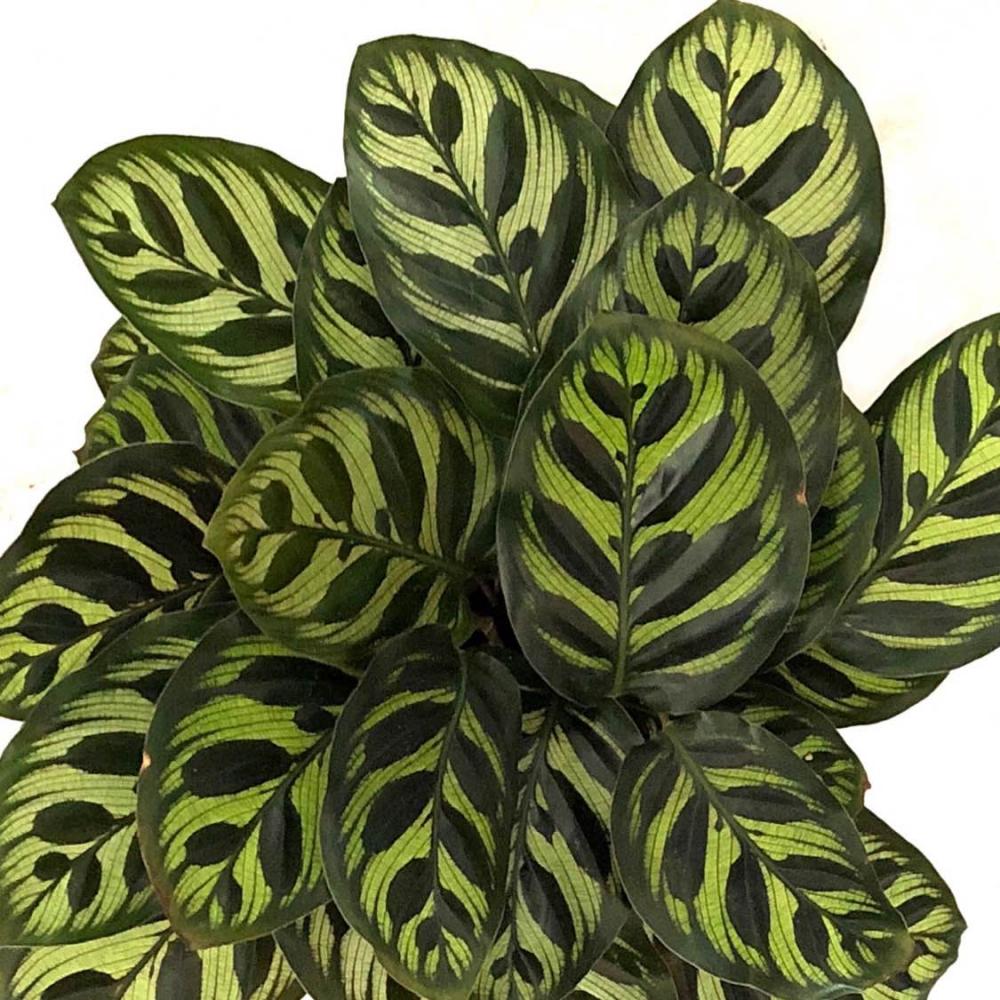植物经验
详细说明
Peacock houseplants (Calathea makoyana) are often found as part of indoor collections, though some gardeners say they’re difficult to grow. Taking care of Calathea peacock and creating conditions in which it will flourish is not difficult when following these simple tips. For information on how to grow a peacock plant, continue reading.
How to Grow a Peacock Plant
High humidity at a level of 60 percent or more, is needed for best performance of the Calathea peacock plant. Many varieties of peacock houseplants offer a range of attractive foliage. No matter the cultivar of peacock houseplants you’re growing, providing humidity is the key to optimum performance.
Providing humidity for peacock plant care Providing humidity for the Calathea peacock plant is as simple as placing bowls of water around the plant. Group peacock houseplants with other humidity loving plants and transpiration offers humidity. A pebble tray located indoors on which plants sit is a good way to provide humidity as well. Frequent misting offers some humidity, but not enough to provide 60 percent in a dry, heated room.
Taking care of Calathea peacock can include frequent, lukewarm showers. Use a spray attachment near a sink or actually put them in the shower with other plants that need high humidity. Fashion a humidity tent to use at night, or cover with a cake cover. A humidifier is a good investment when growing peacock houseplants too.
Add peat-based potting mix (2 parts peat and 1 part perlite) to the pot. The quality of the planting mix ensures good health of the plant.
Once you leave the nursery, see to it that plant roots do not dry out or get damaged before you place the plant into the pot filled with soil.
The soil should hold moisture. It should be well-drained too. Otherwise, the roots would rot.
See to it that the potting mix is moist. Water the plant regularly during the growing season. Avoid warm or cold water, use water at room temperature. This would help prevent 'shocking' the root system.
Regular pruning and timely removal of brown leaves can help maintain the height of the plant.
Additional tips for peacock plant care
Start with a healthy plant when learning how to grow a peacock plant. Resist the small nursery plant with browning leaf margins or poor leaf color, as it likely cannot be nursed into a full recovery. Place this plant in low to moderate light environment.
Peacock plant care includes keeping the soil consistently moist. Foliage of the Calathea peacock plant can be damaged by fluoride in water. Collect rainwater for watering peacock houseplants, or use bottled, distilled water without fluoride.
Use high nitrogen fertilizer when feeding Calathea peacock plant to avoid pale leaves or brown spots on the leaves. These can also occur when using too much fertilizer high in phosphorus. Leach the soil periodically to remove salts left from fertilization.
Potential Problems
Leaves curling and spots: Your likely to have been under-watering your plant. Is the soil dry or has it been drying out frequently? This is easy to resolve by watering and being more consistent with keeping the soil moist at all times.
Leaf tips brown: Most likely cause here is dry air and lack of humidity. The solution is to increase humidity levels.
Leaves dropping: Again, the air could be too dry and the humidity may need to be increased.
Limp stems: You may have been over-watering the plant during the winter and providing low temperatures. Follow the above watering and temperature guidelines.
Attack by pests:
Spider mites, scale, mealy bugs, and aphids can affect the health of your plant, especially if the plant is grown in arid conditions. Regular inspection and spraying is essential to avoid diseases. High humidity is essential for the plant, but it also promotes bacterial and fungal growth. Water the plant when the uppermost layer of the soil (an inch below the surface) is dry.
Repotting Calatheas
Use a glazed ceramic or plastic pot with at least two drainage holes at the base. Choose one that measures 1 to 2 inches larger than the original pot. Avoid using a catch-pot since they lack adequate drainage and will cause the soil to stagnate.
Mix two parts peat moss or milled coir, two parts perlite and one part potting soil in a bucket. Drizzle water onto the components while mixing them together. Keep adding water and stirring until the mixture is evenly moist and has a uniform appearance.
Place a coffee filter or paper towel over the drainage hole in the bottom of the pot to keep the soil from washing away. Fill the bottom one-third of the pot with the soil mixture and firm it well with your fingertips.
Remove the zebra plant from its original pot. Place your hand over the opening with the stems between your fingers. Carefully flip the pot upside-down and jiggle it to loosen the rootball. Guide the plant from the pot without tugging on the stems or leaves.
Crumble away one-third of the soil from around the roots. Gently tease apart the roots with your fingertips so they hang freely. Inspect the rootball and use small scissors to snip off any black or damage roots.
Hold the zebra plant in the pot so its roots touch the surface of the soil and the base of the stems rest just below the top edge of the pot. Add small amounts of soil around the roots until they are covered. Mist the soil occasionally to settle it.
Add soil until the zebra plant's entire rootball is buried. Firm the soil gently with your fingertips to anchor the plant. Water it to a depth of 2 inches and position it in the same spot where it originally grew.
----------
LIGHT
A Calathea Plant likes bright indirect light; so placing it in front of an east, west, or north window is ideal. Too much direct sun burns the leaves of a Calathea Plant and causes the beautiful leaf colors to fade.
WATER
Calathea Plants are very sensitive to the water you use. Hard water, soft water, fluoridated water, or water of poor quality causes the leaves of a Calathea Plant to turn brown from leaf burn. The best way to water a Calathea Plant is to use distilled water, rain water, or allow your tap water to sit out over night before using it. Keep the soil of a Calathea Plant moist but never soggy. Allow the top 2-3” to dry out before watering. Never let a Calathea Plant sit in water.
FERTILIZER
Feed a Calathea Plant monthly in the spring, summer, and fall with a basic houseplant food at ½ the recommended strength. Don't fertilize a Calathea Plant if it is not growing.
TEMPERATURE
Calathea Plants like temperatures between 65-80 degrees, and do not like cold drafts or temperatures below 55-60 degrees. Hot temperatures cause the leaves of a Calathea Plant to curl.
HUMIDITY
High humidity is a must for a Calathea Plant. A Calathea Plant gets brown leaf edges when the air is too dry. Humidity can be increased by placing your Calathea Plant on a tray of wet pebbles (be sure the pot is on the pebbles and not in the water), setting a humidifier close by, or by grouping plants together to create a greenhouse effect.
FLOWERING
The leaves of a Calathea Plant are more beautiful than many of the flowers on other indoor plants. With over 300 types of Calathea Plants, some varieties, such as Calathea Crocata, White Ice, and Brazilian have lovely flowers as well as spectacular leaves.
PESTS
Spider mites, scale, Mealy Bugs and Aphids are houseplant pests that can be a problem for Calathea Plants.
DISEASES
The high humidity that a Calathea Plant needs, encourages bacterial and fungal diseases which usually manifest themselves as leaf lesions.
SOIL
Use a good light porous indoor potting soil that retains water but still drains quickly for Calathea Plants. African Violet soil works well for Calatheas.
POT SIZE
A Calathea Plant rarely need repotting.
PRUNING
Cut off brown or crispy Calathea leaves as soon as they appear.
PROPAGATION
Calatheas Plants are propagated by plant division but it is a little difficult.
POISONOUS PLANT INFO
Calatheas are non- Poisonous Houseplants.
How to Grow a Peacock Plant
High humidity at a level of 60 percent or more, is needed for best performance of the Calathea peacock plant. Many varieties of peacock houseplants offer a range of attractive foliage. No matter the cultivar of peacock houseplants you’re growing, providing humidity is the key to optimum performance.
Providing humidity for peacock plant care Providing humidity for the Calathea peacock plant is as simple as placing bowls of water around the plant. Group peacock houseplants with other humidity loving plants and transpiration offers humidity. A pebble tray located indoors on which plants sit is a good way to provide humidity as well. Frequent misting offers some humidity, but not enough to provide 60 percent in a dry, heated room.
Taking care of Calathea peacock can include frequent, lukewarm showers. Use a spray attachment near a sink or actually put them in the shower with other plants that need high humidity. Fashion a humidity tent to use at night, or cover with a cake cover. A humidifier is a good investment when growing peacock houseplants too.
Add peat-based potting mix (2 parts peat and 1 part perlite) to the pot. The quality of the planting mix ensures good health of the plant.
Once you leave the nursery, see to it that plant roots do not dry out or get damaged before you place the plant into the pot filled with soil.
The soil should hold moisture. It should be well-drained too. Otherwise, the roots would rot.
See to it that the potting mix is moist. Water the plant regularly during the growing season. Avoid warm or cold water, use water at room temperature. This would help prevent 'shocking' the root system.
Regular pruning and timely removal of brown leaves can help maintain the height of the plant.
Additional tips for peacock plant care
Start with a healthy plant when learning how to grow a peacock plant. Resist the small nursery plant with browning leaf margins or poor leaf color, as it likely cannot be nursed into a full recovery. Place this plant in low to moderate light environment.
Peacock plant care includes keeping the soil consistently moist. Foliage of the Calathea peacock plant can be damaged by fluoride in water. Collect rainwater for watering peacock houseplants, or use bottled, distilled water without fluoride.
Use high nitrogen fertilizer when feeding Calathea peacock plant to avoid pale leaves or brown spots on the leaves. These can also occur when using too much fertilizer high in phosphorus. Leach the soil periodically to remove salts left from fertilization.
Potential Problems
Leaves curling and spots: Your likely to have been under-watering your plant. Is the soil dry or has it been drying out frequently? This is easy to resolve by watering and being more consistent with keeping the soil moist at all times.
Leaf tips brown: Most likely cause here is dry air and lack of humidity. The solution is to increase humidity levels.
Leaves dropping: Again, the air could be too dry and the humidity may need to be increased.
Limp stems: You may have been over-watering the plant during the winter and providing low temperatures. Follow the above watering and temperature guidelines.
Attack by pests:
Spider mites, scale, mealy bugs, and aphids can affect the health of your plant, especially if the plant is grown in arid conditions. Regular inspection and spraying is essential to avoid diseases. High humidity is essential for the plant, but it also promotes bacterial and fungal growth. Water the plant when the uppermost layer of the soil (an inch below the surface) is dry.
Repotting Calatheas
Use a glazed ceramic or plastic pot with at least two drainage holes at the base. Choose one that measures 1 to 2 inches larger than the original pot. Avoid using a catch-pot since they lack adequate drainage and will cause the soil to stagnate.
Mix two parts peat moss or milled coir, two parts perlite and one part potting soil in a bucket. Drizzle water onto the components while mixing them together. Keep adding water and stirring until the mixture is evenly moist and has a uniform appearance.
Place a coffee filter or paper towel over the drainage hole in the bottom of the pot to keep the soil from washing away. Fill the bottom one-third of the pot with the soil mixture and firm it well with your fingertips.
Remove the zebra plant from its original pot. Place your hand over the opening with the stems between your fingers. Carefully flip the pot upside-down and jiggle it to loosen the rootball. Guide the plant from the pot without tugging on the stems or leaves.
Crumble away one-third of the soil from around the roots. Gently tease apart the roots with your fingertips so they hang freely. Inspect the rootball and use small scissors to snip off any black or damage roots.
Hold the zebra plant in the pot so its roots touch the surface of the soil and the base of the stems rest just below the top edge of the pot. Add small amounts of soil around the roots until they are covered. Mist the soil occasionally to settle it.
Add soil until the zebra plant's entire rootball is buried. Firm the soil gently with your fingertips to anchor the plant. Water it to a depth of 2 inches and position it in the same spot where it originally grew.
----------
LIGHT
A Calathea Plant likes bright indirect light; so placing it in front of an east, west, or north window is ideal. Too much direct sun burns the leaves of a Calathea Plant and causes the beautiful leaf colors to fade.
WATER
Calathea Plants are very sensitive to the water you use. Hard water, soft water, fluoridated water, or water of poor quality causes the leaves of a Calathea Plant to turn brown from leaf burn. The best way to water a Calathea Plant is to use distilled water, rain water, or allow your tap water to sit out over night before using it. Keep the soil of a Calathea Plant moist but never soggy. Allow the top 2-3” to dry out before watering. Never let a Calathea Plant sit in water.
FERTILIZER
Feed a Calathea Plant monthly in the spring, summer, and fall with a basic houseplant food at ½ the recommended strength. Don't fertilize a Calathea Plant if it is not growing.
TEMPERATURE
Calathea Plants like temperatures between 65-80 degrees, and do not like cold drafts or temperatures below 55-60 degrees. Hot temperatures cause the leaves of a Calathea Plant to curl.
HUMIDITY
High humidity is a must for a Calathea Plant. A Calathea Plant gets brown leaf edges when the air is too dry. Humidity can be increased by placing your Calathea Plant on a tray of wet pebbles (be sure the pot is on the pebbles and not in the water), setting a humidifier close by, or by grouping plants together to create a greenhouse effect.
FLOWERING
The leaves of a Calathea Plant are more beautiful than many of the flowers on other indoor plants. With over 300 types of Calathea Plants, some varieties, such as Calathea Crocata, White Ice, and Brazilian have lovely flowers as well as spectacular leaves.
PESTS
Spider mites, scale, Mealy Bugs and Aphids are houseplant pests that can be a problem for Calathea Plants.
DISEASES
The high humidity that a Calathea Plant needs, encourages bacterial and fungal diseases which usually manifest themselves as leaf lesions.
SOIL
Use a good light porous indoor potting soil that retains water but still drains quickly for Calathea Plants. African Violet soil works well for Calatheas.
POT SIZE
A Calathea Plant rarely need repotting.
PRUNING
Cut off brown or crispy Calathea leaves as soon as they appear.
PROPAGATION
Calatheas Plants are propagated by plant division but it is a little difficult.
POISONOUS PLANT INFO
Calatheas are non- Poisonous Houseplants.
花相册 (5)
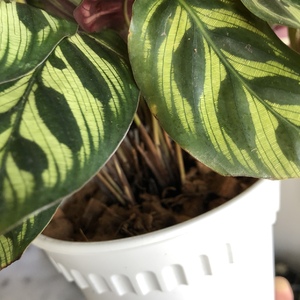
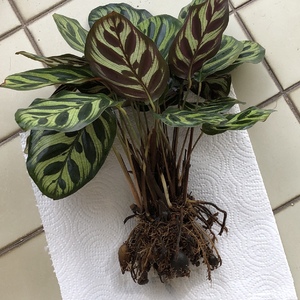

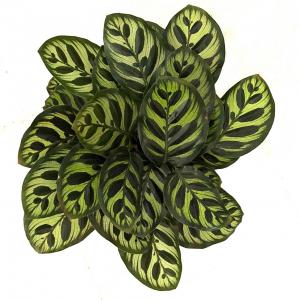
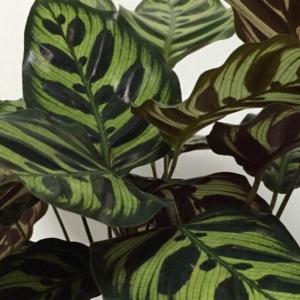
kensong
2018年06月02日

Repotted my Calathea to a better draining pot and discovered mealy bugs in the soil. Had to thoroughly clean the roots.




kensong
2018年03月15日

This is my first growing diary.




